#Vanlife Lessons: What I Learned During My First 2 Months Of Living, Working & Traveling In A Van
People know me as the “Bicycle Touring Pro” because, for the last 17 years, I’ve been traveling around the world on my bicycle and teaching people like you to conduct their own incredible bicycle touring adventures. But this autumn, rather than going on another big bike tour in some foreign country, I decided to try something a little different and travel in a way I’ve never done so before!
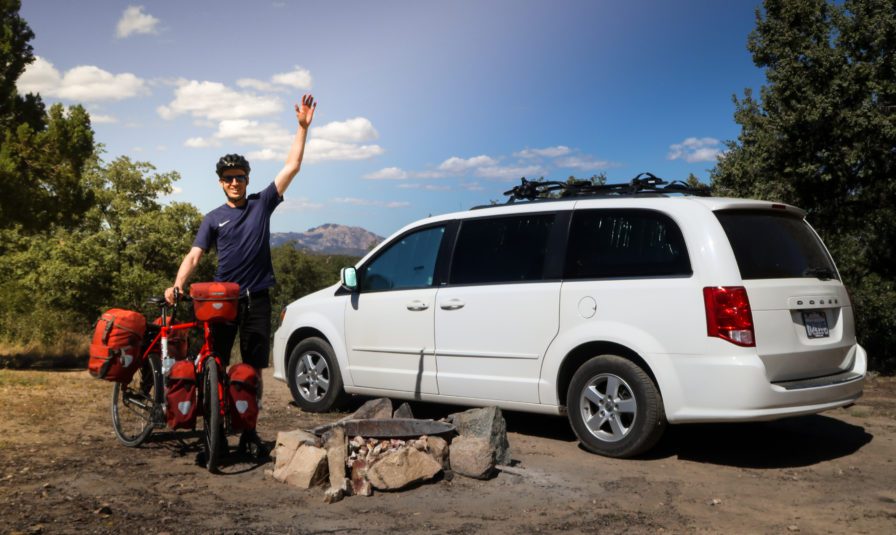
Podcast: Play in new window | Download
Subscribe: RSS
MY VANLIFE STORY: In late September of 2017, I took off in a white 2011 Dodge Caravan that I purchased from a used car lot in Oxnard, California. With two bicycles and everything else I happen to own loaded into the van, I set out on a three-month-long road trip across the American Southwest.
Starting in San Diego, California, I traveled east toward the Anza-Borrego Desert, then on to the cities of Prescott, Sedona and Flagstaff in Northern Arizona. After spending some time bikepacking on the North Rim of the Grand Canyon, I continued on to Monument Valley and the tiny town of Mexican Hat in Southern Utah. Then I drove east to Durango, Colorado and north to the resort town of Aspen, where I visited with my sister and her boyfriend for a couple days. Then I drove south to the small, snow-covered town of Buena Vista, Colorado, which is where I’ve been sleeping and cycling for the past five nights or so… and where I happen to be writing this article from at this very moment.

I’ve been on the road for about a month-and-a-half now and things are going pretty well. There have been a few things I’ve needed to get used to with living and working in my van, and there have been a few small emergencies along the way, but overall, I’m loving the #vanlife and I can’t wait to do more of it in the future!
Why Try Vanlife?
“Why would I switch from bicycle touring to #vanlife (traveling, working and living in a van)?”
Well, that’s a good question! But it’s important to note that I haven’t given up on bicycle touring entirely. I’m just bicycle touring in a slightly different manner at the moment.
Let me explain: Instead of using my bicycle as my one and only means of transportation, I’m using my van to carry me and my bicycles to some of the most interesting and bike-friendly locations in the American Southwest. Once in those locations, I simply unload the bicycles from my van and go on a ride!

In some areas I’ve done only short day rides. In other locations I’ve done overnight bike tours. And in some places I’ve done little to no cycling at all, and have simply lived, worked and slept out of my van.
Ultimately, there were a number of different reasons I wanted to try the “vanlife” (as it is called) for myself.
First of all, vanlife is kind of in the social zeitgeist at the moment. It’s a popular trend on Instagram, YouTube and other popular social media platforms. Lots of people are doing it! In fact, I have at least five different friends who have done some version of living out of a van, either in the United States or abroad, and it’s something that has appealed to me personally for a very long time.
After all, vanlife is a lot like bicycle touring. You pack up everything you own, cover a certain distance each day and then find a place to eat and sleep in the evening. Vanlife and bicycle touring have a lot more in common than you might think!
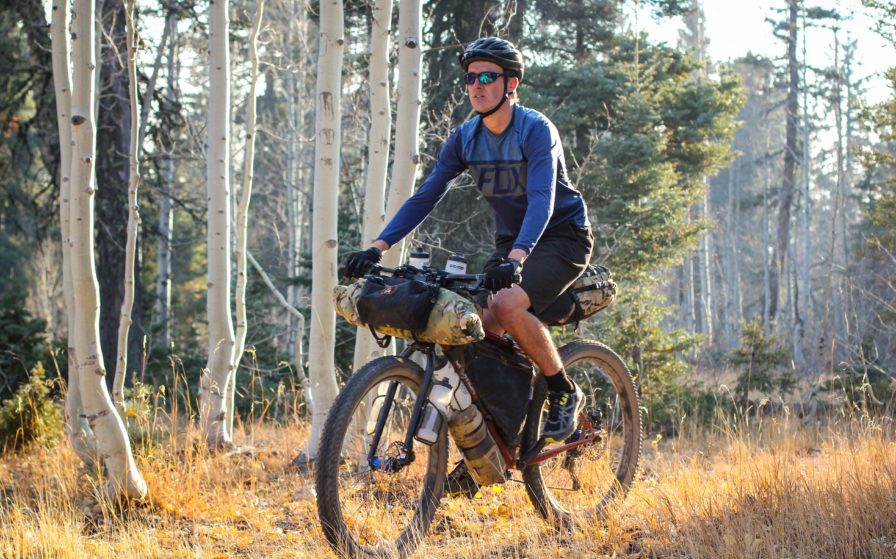
Another reason I wanted to go bicycle touring with my van and do these short mini-bike tours in interesting locations along the way is because I wanted to show you and my other readers here at Bicycle Touring Pro that you don’t need weeks, months or years of free time to go bicycle touring. If you have a spare weekend, you can conduct an epic bicycle touring adventure close to where you live! I’m hoping to show that with just a little spare time, a bicycle, and a healthy appetite for adventure, there are some incredible cycling destinations close to where you live!
The third reason I wanted to try traveling with a van is because I’ve already cycled across the United States in six different directions (north, south, east, west, etc) on six previous long-distance bike tours and I just don’t have it in me at the this moment to do another long bike tour across the United States. I’ve done that already… and I don’t really want to repeat experiences I’ve already had in the past.
However, I did want to do some bike touring in the United States and I wanted to show my readers at www.bicycletouringpro.com just how good the cycling can be in North America. As it turns out, driving around to some of the best spots in the USA with my bicycles in tow has turned out to be a great way to accomplish both of those goals!
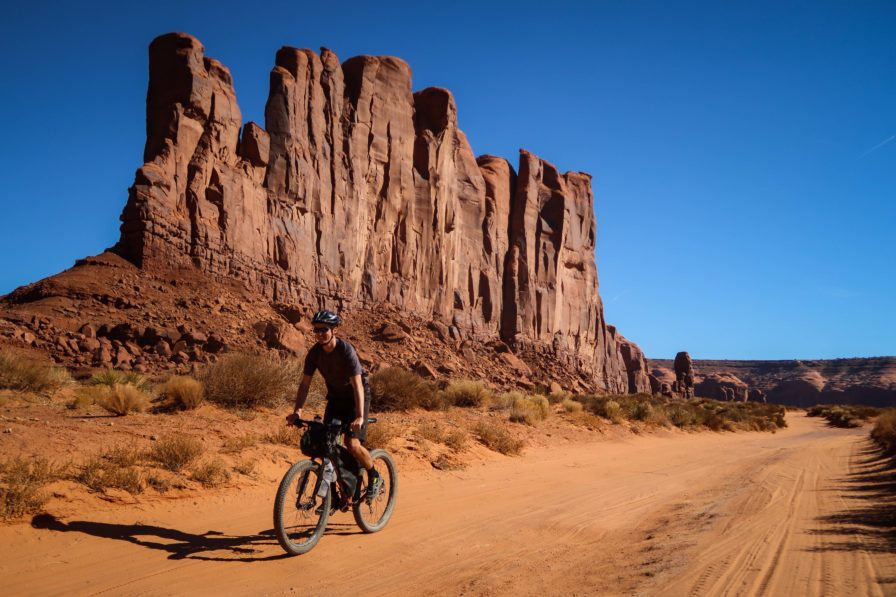
Finally, the last (and maybe the biggest) reason I decided to try #vanlife now is because I was recently diagnosed with cancer and I’ve been in the recovery process ever since. Since getting cancer, having surgery, and receiving treatment from my doctors, I’ve cycled across 9 different countries in Europe, North America and South America, but, to be completely honest, I’m getting tired.
I spent the first few months of 2017 bicycle touring in Colombia and Ecuador, and even though I enjoyed my cycling experiences in those two countries, I was really struggling at the time. I couldn’t find much healthy food to eat, I was battling anxiety attacks and dizziness, was hospitalized on two separate occasions, and ultimately lost more than 12 lbs by the end of my bike tour in those two countries (because I wasn’t eating enough – because I couldn’t find any food that I liked).
I came home from that bike tour in South America… and I was beat! I realized at that time that maybe going off to these difficult foreign countries at this point in my life is not the best idea in the world.
I did, however, end up spending three additional months this summer cycling across Sweden, Finland and Norway in northern Europe, but the conditions there are a whole lot nicer than they were in South America – the food was good and I felt relatively healthy.
So, when it came time for me to start planning my next big bike tour, I decided that I was going to stay away from those far away, difficult bicycle touring destinations for a while, and I was going to do something a little closer to home. Not only would traveling around the USA with my bikes in the van be a whole lot easier on my body, but it would allow me to rush back to my doctors in Southern California if there happened to be any signs of the cancer returning.

I realize this is all pretty negative and a bit of a downer, but the truth is, I’m still in the 3-year danger window in which my particular type of cancer is most prone to return and/or spread to another part of my body, so driving around the United States for a few months is my way of continuing to bike tour, while at the same time staying close to home and taking care of my health.
Truth be told, I’d rather be off cycling in some foreign part of the world (like Morocco or Siberia), but for the time being, I’ve made the decision to stay close to home, take it easy on my body, and explore some of the best cycling destinations in my home country.
What Type Of Van Did I Buy?
I spent a long time looking at different camper vans, cargo vans, and utility vans on the Internet. I watched all the vanlife videos on YouTube and talked to my friends who have done some #vanlife traveling of their own in the recent past.
After all of my research, I decided not to buy an official camper-van or even a cargo van of any kind. Instead, I decided to buy a minivan!

There were three main reasons I opted for a minivan instead of a big cargo or camper van:
- Campers and cargo vans are pretty expensive. I just didn’t want to spend a lot of money on a new van… and, on the other-hand, I was a little nervous about buying a cheap used van that might have mechanical issues once I got out on the road. So, I wanted to spend less money! (PS – Yes, I’m a cheapskate.) Ultimately, money had a lot to do with my decision.
- I wanted a vehicle that was going to be relatively fuel-efficient. I didn’t want to have a big vehicle that sucked up gas and money like there was no tomorrow. I wanted to have a vehicle that got a good gas mileage and wouldn’t be too costly for me to drive long distances.
- Finally, I wanted to get a vehicle that was relatively stealthy. I do a lot of stealth camping on my bicycle tours and I personally love this form of traveling. I wanted to the same thing in my van! So, I wanted a vehicle that, if someone were to see it, they wouldn’t instantly think, “I bet you there’s someone sleeping inside that van.” I wanted a vehicle that I could park in an urban or suburban environment and no one would even suspect that I was inside and sleeping.
In the end, I settled on a white 2011 Dodge Caravan that I found for sale at my local CarMax. The car had approximately 55,000 miles on it and it came with a number of the extra features I wanted in my van (such as a roof rack, a 110 Volt electrical outlet, and fold-down middle and rear seats).

In fact, the reason I settled on the Dodge Caravan over any other type of minivan is because of those fold-down seats in the back of the van.
Normally, the 2011 Dodge Caravan (and every Caravan model since 2011, I believe) has featured middle and rear row seats that fold down into the floor of the van with they are not in use. So, if you want to carry a bunch of stuff in the back of the van, you can fold the seats down into the floor and the entire back of the van in flat and open for storage. But then, if you want to carry a bunch of kids (or friends in the van) you can easily fold the seats out of the floor and have seating for seven people.
I, however, knew I wouldn’t need seating for seven people. Instead, I knew that I was going to need lots of room for storage. And I knew that if I could rip out the middle row seats, I would have a huge area in the floor of the van where I could safely store all my belongings.
So, that’s exactly what I did during my first day with the van. I ripped out the middle row of seats and was surprised by how much room I suddenly had to store all my belongings in the floor of the van. Boom!!! – Instant storage solution.
Which Bicycles Are You Using?
Because I’m traveling in a van and because I’ve got the space for it, I decided to travel across the American Southwest with two very different different bicycles.
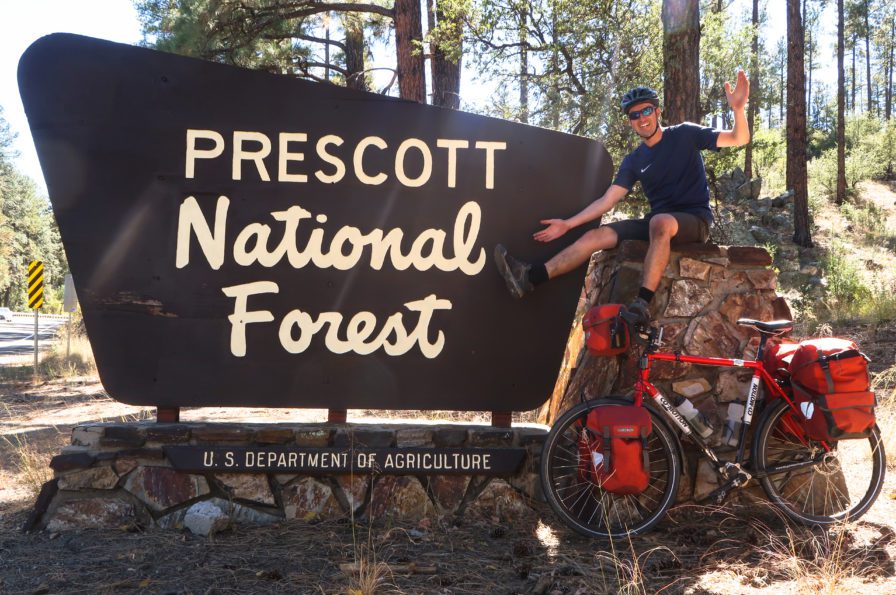
The first bike I brought with me is my Co-Motion Cycles Siskiyou touring bicycle, which happens to be the same bicycle I used on my recent bike tour across Sweden, Finland and Norway this summer. This is my road-based touring bicycle for my vanlife/bike tour.
The second bike I brought with me on the van trip is a bicycle that I actually just received at the start of this tour. It’s a Chumba USA Ursa 29+ mountain bike… and it is a bicycle designed specifically for off-road bikepacking adventures.

So, I have one bicycle for traditional road-based bicycle touring… and I have another bicycle designed for mountain biking, off-road riding, and short bikepacking trips.
I’ll be publishing a complete review of both my Co-Motion Siskiyou and my Chumba Ursa 29+ here on www.bicycletouringpro.com sometime in the near future, but for now, just know that I Iove both of these bicycles and I would recommend them both to anyone.
Where Do You Store Everything?
Storage has been one of my biggest problems with traveling in my van. It’s not that I have a lot of things, because I don’t. It’s just that there are lot of things I’m still not 100% sure where to put them so that they are out of the way… and so it doesn’t look like there’s a homeless person living in my van.
The big difference between myself and so many other people living the #vanlife is that my bicycles are a big part of what I’m doing out here. In fact, my bicycles are my job, my source of income and my main passion. Because my bikes are so important to me, and because my two bicycles are worth more than $10,000 USD together, I wanted to make sure that my bikes were never stolen.

I bought two Thule Proride bike racks so I could store the bicycles on the top of my van, but I also knew that I wasn’t going to want to keep the bikes on the roof of the van at all times. I knew that there would be instances when I’d be stepping away from my van for long periods of time, and I didn’t want to leave my very expensive bicycles just sitting on the roof of my vehicle, out in the public and drawing attention to themselves. So, I knew from the very beginning that I wanted to have the option the store the bicycles either on the roof or inside the van (where no one would be able to see them and they’d be more secure).
So, right away, I’ve got two very big things taking up a lot of space inside the van. Luckily, if I lower just the one seat in the far right-back corner of the van, both bicycles slide into this space and remain there (even when the van is in transit) thanks to two small bungee cords I’ve got mounted on the right-hand side of my vehicle.
This leaves me with a slightly larger empty space on the left side of the van where I can sit, work on my computer, prepare food, store some of my additional belongings, and at the end of the day, fold out my mattress and go to sleep.
This set up has worked well for me. I don’t really mind having the bicycles inside the van with me (and I certainly sleep better knowing that the bikes are safe inside the van), yet I still wish there were some way for me to store the bikes outside the van at all times, without having to worry about them getting stolen. If the bikes were always on the roof, for example, I’d have a whole lot more room inside the van for food storage, a small kitchenette, or some of the other luxuries you oftentimes see in other people’s campervan setups.
Where Do You Sleep?
First of all, like I said at the top of this article, I’ve been on the road for about one-and-a-half months at this point in time… and I have yet to pay even a single cent for lodging, camping or sleeping. Instead, I’m sleeping in national forests, state parks and free campgrounds located on land owned by the United States government.
Can you spot my white van parked among the trees in the photo below? This was one of my free campsites outside the city of Flagstaff, Arizona.
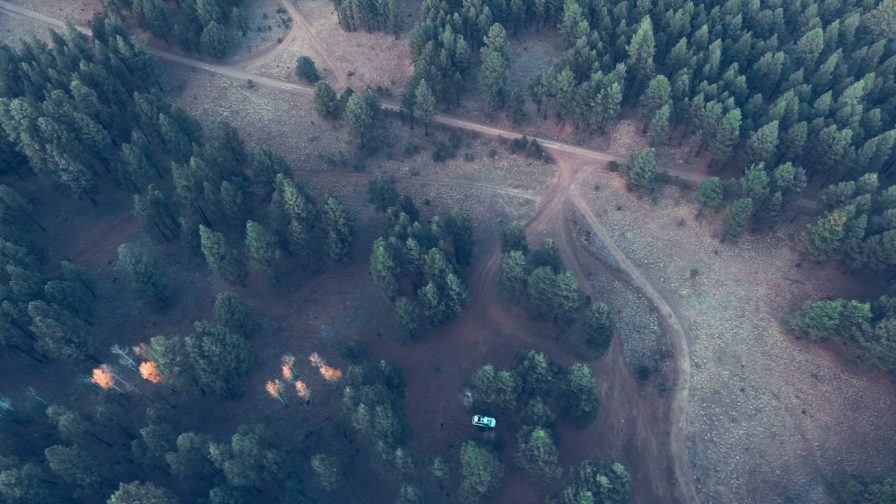
My number one resource for finding these free campsites is a website called www.freecampsites.net. Just go there, type in the area you are hoping to camp in, and a whole list of free campsites will pop up on your screen.
Before I left home, I programed all of the free campsites along my route in the American Southwest into the Maps.me application on my smartphone, so now I can look at my offline mapping application at any time and easily find the campgrounds in my area without having to refer back to the “Free Campsites” website.
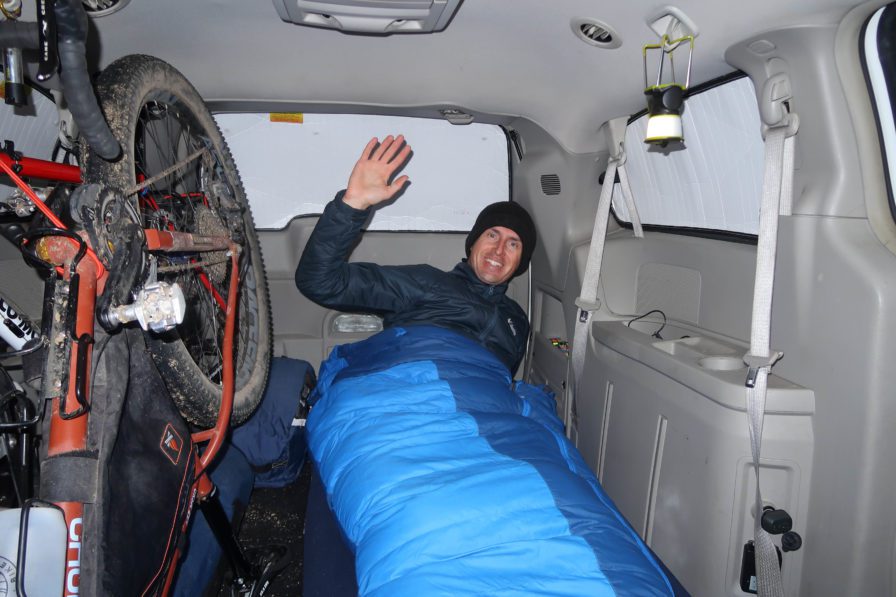
Secondly, when it comes to where exactly I’m sleeping inside the vehicle, I do not have a dedicated bed area inside the van. Instead, I use the rear two seats inside the mini van as my chair, desk and food preparation/eating area during the day. Then, when I’m ready to go to bed at night, I fold the rear seats down into the floor of the van and I lay out a large 4 inch thick foam mattress that I purchased on Amazon.com for about $80 USD. The mattress is cot-sized and covered in a single sheet. And on top of the sheet/mattress I place my sleeping bag. This is my bed inside the van, and it’s extremely comfortable! I’m pretty happy with it.
How Do You Shower & Go To The Bathroom?
Going to the bathroom is simple. I either use public restrooms (at gas stations, restaurants, cafes, supermarkets or libraries) or I simply go to the bathroom somewhere in the wild. I do not have a toilet, sink or shower inside my van.
I’ve gotten a lot of practice going to that bathroom in the wild, thanks to my 17+ years of bicycle touring experiences all around the world, so those skills translate over very easily to living in a van.
Having the van is nice though because instead of only carrying one or two rolls of toilet paper (like I might do on my bicycle tours), I can carry a 12-pack of toilet paper inside my van. And because I’m in a van and I have room for extras I might not otherwise be able to travel with on a bicycle. For example, I’ve got a small spade that I can dig holes with and several small bottles of hand sanitizer, which I use after every bathroom break.

While going to the bathroom has been no issue for me over the last month-and-a-half, getting a shower has been one of my biggest difficulties.
Because I’m staying in free campsites on public land most of the time, there are no showers available to me. I could stay at a privately owned campground and take a shower there, but I really dislike private campgrounds where they pack you in among a group of noisy neighbors, so I’ve been sticking to the free campsites and taking showers only when I can find them.
In the 45 days I’ve been on the road, I’ve only had about 4 or 5 showers, which means I’m only getting a shower every 10 days or so.
That might sound horrible to you, but the truth is, it hasn’t been that bad. The weather at this time of year is cool, so that helps to keep my body from sweating, which would make not showering for such a long period of time even worse. Plus, some days all I do is sit in the van or drive from one location to the next. That doesn’t cause much dirt to pile up on my body!
Most importantly, because I’m in a van, I’m also carrying a large 7-gallon water tank, which I use mostly for drinking water, but also use to cook with, wash my van with, and wash my body with at the end of each day. I even bough a little spray bottle that I use to spray myself down so I can easily remove all the dirt and grime that has accumulated on my body over the previous 24+ hours.
This, in combination with washing up as best I can inside public restrooms, has kept me relatively clean on most days of my vanlife/bike tour. No, I’m not as clean as I would be if I were wearing fresh clothes every day and taking a shower every morning and/or night, but I’m clean enough!
Like I said before, I’ve been bicycle touring around the world for 17+ years, and anyone who is going to travel in that way has to get used to not having a shower each day. It’s simply something you get used to… and I’ve found that keeping clean in a van is a whole lot easier than keeping clean when you’re traveling with a bicycle as your only means of transportation.
PS – When it comes to doing laundry, the solution is simple – go to a laundromat! There are lots of public laundromats in the cities I’ve been visiting on my vanlife/bike tour across the American Southwest. Once you start looking for them, you start to see them everywhere!
How Do You Power Your Electronics?
Because I planned to live, work and travel in my van for months at a time, I knew I was going to need a way to power all of the various electronics I’d be carrying with me – my laptop, drone, cameras, GoPro video camera, smartphone, bike lights, etc.
It was easy for me to determine that a solar system would be my best option for keeping all my electronics charged while I was out there on the road.
I watched a bunch of videos on YouTube, read a few articles, and then went to Amazon to order everything I’d need for my small, off-the-grid solar power setup. I ordered a 100 watt flexible solar panel, a Renogy solar charge controller, a 100AH deep-cycle battery, an inexpensive power inverter and all the necessary cables. The total cost for everything I needed was about $600 USD.
I’ll go into the details of my solar system, how exactly it all works, and how I installed it all inside my van in a future article/video/podcast here on www.bicycletouringpro.com.

For now, just know that the solar system works pretty well. The panel I purchased is incredibly thin, and because of the way I have it mounted on the roof, you can hardly even tell that it is there! This I greatly appreciate, because I don’t really want it to be obvious to anyone walking or driving past my van that I have valuable electronics inside my vehicle.
That being said, because the solar panel is mounted flat on the top of the van and is not pointed directly at the sun most of the time, charging the battery is an extremely slow process and my power consumption is far greater than what my existing 100 watt solar panel can handle.
This is why I’ve since reconfigured my entire solar setup so that I can now easily remove the solar panel from the roof of the van whenever I’m stopped in campsite for a few hours. Then, I can position the solar panel so it points directly toward the sun. This makes a HUGE difference when it comes to how much power I can generate off the solar system. With the solar panel pointed directly at the sun, I have found that I can generate 3-12 times more amps than I would be able to with the solar panel mounted flat on the roof of the van.
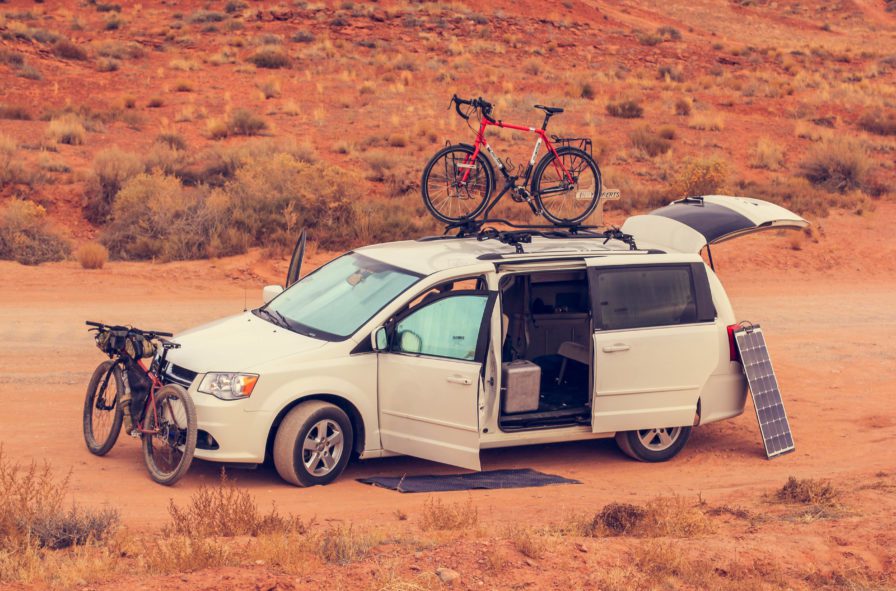
In the future, I’d like to add a second solar panel to the roof, as I believe this would help considerably with keeping my battery topped off in the way that I need it to be. I plan to set it up so that one of the 100 watt solar panels will always be mounted flat on the top of the van, while the other panel can be removed and positioned in such a way so that it generates the most electricity possible.
Have There Been Any Problems With The Van?
Yes, there have been a couple problems with the van, now that you mention it.
When I was in Flagstaff, Arizona, I noticed that the brakes on the van were suddenly not working as well as they had been previously. The pedal would go almost all the way to the floor before the van would suddenly come to a sudden halt. This was not good!
I took the van to University Auto Repair in Flagstaff and even though they looked at the vehicle and were able to see the problem, they told me they’d be unable to fix it and that I should take it to a certified Dodge dealer instead. This was not what I wanted to hear!
After paying them $50+ USD just to look at the van (and not solve my problem), I then took the van to a nearby Brake Masters, where they informed me it was my master cylinder (something I had suspected myself, based on the information I gleamed online before taking the car to any of the auto repair shops in town). The master cylinder needed to be replaced… and so did all four struts on the front and back of my van. Ugh!
I happened to purchase the additional insurance when I initially bought my van, so luckily the insurance company covered a significant portion of my $1,450+ USD bill, but it still cost me about $550 USD in cash to get my van fixed. Plus, it took two whole days for the van to be repaired! I spent that time walking around the city like a homeless person, which was no fun at all!
Other than the issue with the brakes, there have been no additional mechanical issues. However, I did have another problem with the van just a few days after getting the brakes fixed.

When I was in Page, Arizona, I drove out onto a dirt road just as it was getting dark in search of a place to camp for the night. It was getting dark and I couldn’t see very well, which is how I suddenly drove the van into some really deep, soft sand. I knew, in an instant, that I was stuck!
I jumped out of the van and started digging the sand out frantically from underneath the tires. I threw a carpet that I had in the back of my van underneath one of the tires on one side of the vehicle and threw a few scraps of cardboard I found laying on the ground under the other tire. It didn’t help! The wheels spun like crazy and the van didn’t move an inch! I was stuck.
Then, just as I was about to call a tow truck, this woman driving a 4×4 Suburban came racing down the dirt road in front of me. Because I was stuck in the middle of the road, she couldn’t get around me. I tried to explain the situation, but the woman was having a predicament of her own and was literally out of her mind!
Just a few moments before running into me, the woman had been walking her four dogs in the remote desert when one of the dogs ran away and never came back. She was worried and panicked about losing her dog… and now she was stuck behind me, unable to move.
The woman yelled at me, told me how stupid I was, and cursed at me in a manner no other individual has ever cursed at me before. Remarkably, I remained calm.
I tried to call the tow truck driver again, but the woman was yelling at me so loudly that I couldn’t hear what the tow company was saying on the other end of the line. Then I lost reception and my call was dropped.
By this time, several people who were also camped out in the nearby area had come over to try and lend assistance. At one point, there were seven or eight of us all digging and pushing and trying to get my van out of the sand.
Then the angry woman said she was going to try and drive around me, but I told her I didn’t think that was a good idea. The sand on the side of the road was even worse than the sand in the middle of the road. I knew that she was going to get stuck in the sand if she tried to go around me… and that is exactly what happened!
The woman tried to drive around me, drove her heavy 4×4 vehicle deep into the sand, and there was no way she could move after that. Now we were both stuck… and the woman was even more upset! Crying, angry and frantic!
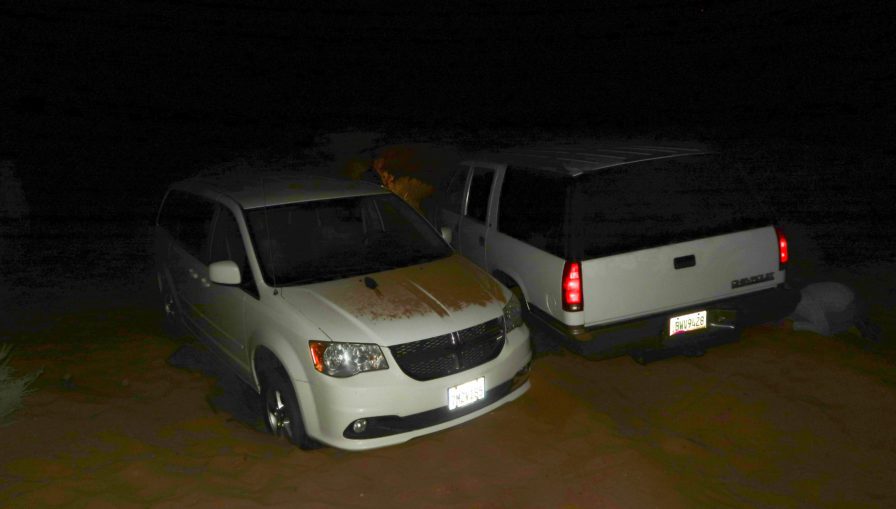
At this point, I knew I had to get away from the angry lady. I ran down the road about a mile to the point where I could get reception on my phone. Then, I called a local tow company in the nearby city of Page and asked them to come out and rescue me.
A stout, Native American tow truck driver arrived on the scene approximately 20 minutes later. He hooked a line up to the back of my van and dragged me out of the sand. Then, he hooked another line up to the woman in her Suburban and pulled her out of the deep sand on the side of the road.
I paid the tow truck driver $50 USD and the woman was forced to pay the driver $60 for her slightly more complicated tow. I apologized to the woman for the inconvenience, but she offered no apology to me for the terrible things she had said during the first few minutes of our encounter. I was going to initially offer to pay the woman’s tow truck fee (because I was the reason she got stuck in the sand in the first place), but she was so mean to me that I decided to just let her pay the $60 fee.
In the end, it wasn’t really that big of a deal. If I had gotten stuck in the sand and that woman in the Suburban hadn’t come down the road at that exact point into time, I would have simply called a tow truck and gotten myself out of there in thirty minutes or less. But because the woman showed up and she was in such a foul state herself, my predicament only escalated. She not only got her vehicle stuck in the sand, but she delayed me from calling the tow truck for nearly two hours, simply because she was yelling at me so loudly I couldn’t hear the people from the tow company talking to me on the other end. And every time I tried to call the tow company, she’d start yelling at me again, insisting that I get down in the sand and start digging.
It was not a fun night! But I guess that’s just the price you have to pay when decide to live the #vanlife.
What Are The Advantages To Traveling With A Van?
Well, there are a lot of positive things about traveling in a van versus traveling on a bicycle. You can carry more food and water in a van, you have a near infinite source of power (thanks to the solar setup), the van is warmer at night compared to sleeping in a tent, you can store a whole lot more things in a van, and you can cover distances that you wouldn’t be able to cover if you were traveling on a bicycle.
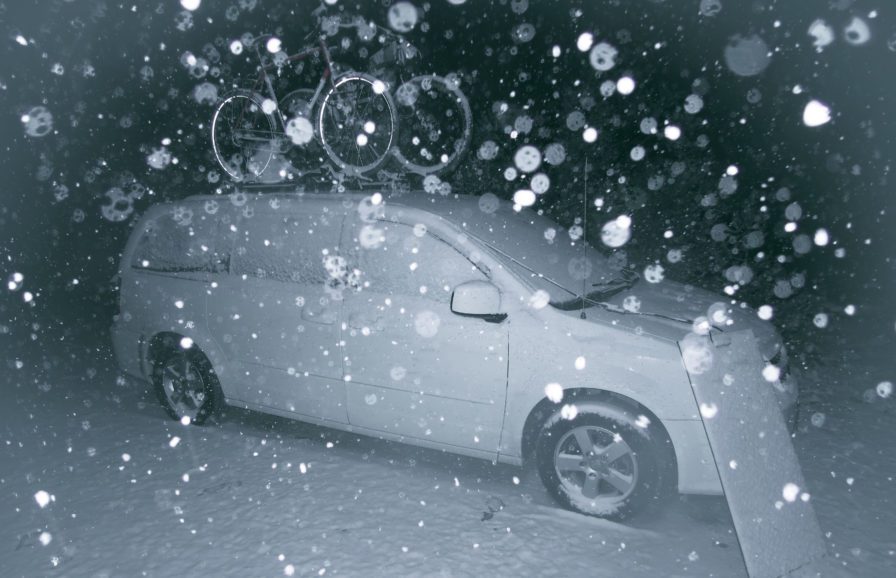
That being said, I think the biggest advantage I’ve received from my vanlife travels thus far is the fact that traveling in a van allows me the opportunity to easily meet up with people I might not otherwise be able to meet up with if I were traveling in some other way.
For example, at the start of my vanlife/bike tour, I traveled to San Diego, California, where I organized a Bicycle Touring Pro reader meetup. 11 people from all across Southern California attended the event and together the 12 of us cycled from Coronado Island to the Mexican/American border and back.
This event would have never happened if I had not had the luxury of traveling to San Diego in my van.
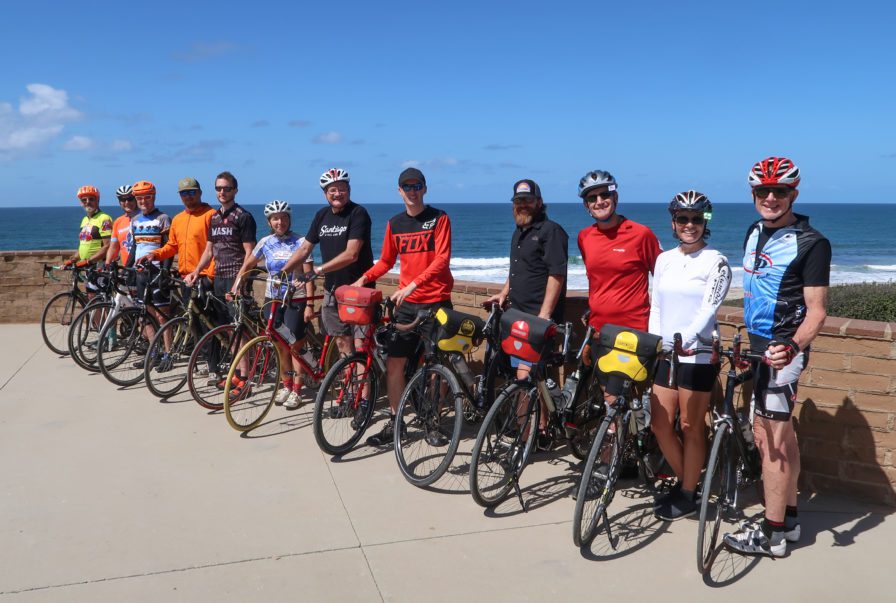
Another example of how the van has allowed me to meet people on the road occurred just yesterday here in central Colorado. You see, when I was in Flagstaff, Arizona a few weeks ago, I climbed Humphrey’s Peak, which is the highest mountain in the state of Arizona. When I was at the top of the mountain, I took a photo with some of the people I met on the trail… and one of those people happened to be a young woman named Becca (pictured below).
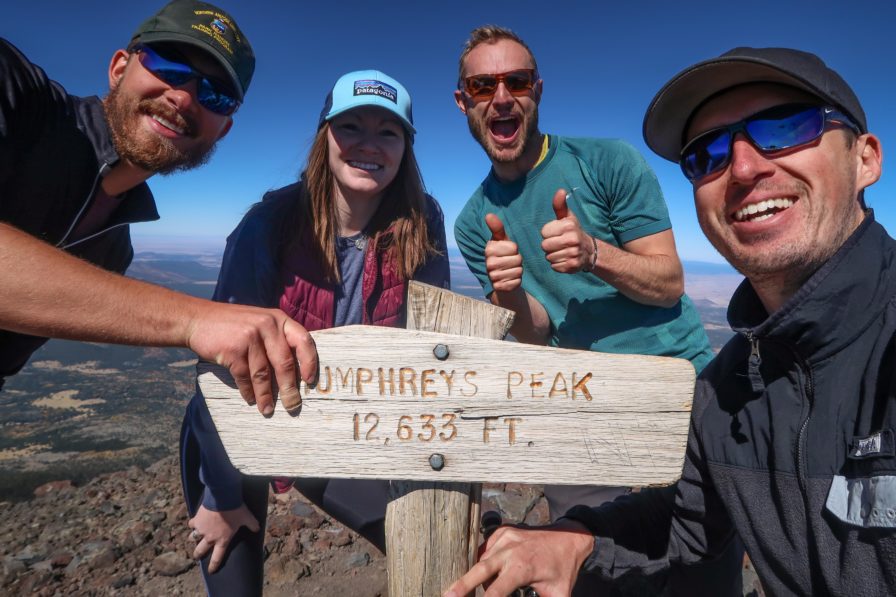
Becca and I kept in touch after the hike… and when Becca saw that I was in Buena Vista, Colorado, she wrote to me and said that she was now in nearby Breckenridge – only 60 miles away. It was then that she suggested we meet up and go on a hike or a short bike ride.
Now, normally, that would have been the end of it. If I were traveling on a bicycle, there’s no way I would have even considered cycling the 60 miles to Breckenridge just to see Becca again. But because I had my van, I was able to drive to Breckenridge for a short hike.
I drove the 1 hour to Breckenridge, went on a short hike with Becca in the mountains outside the city, went over to her place to take a quick shower (which she was kind enough to offer after I told her it had been five days since I last had a shower), and then I drove back to Buena Vista, where I had been staying the night before.
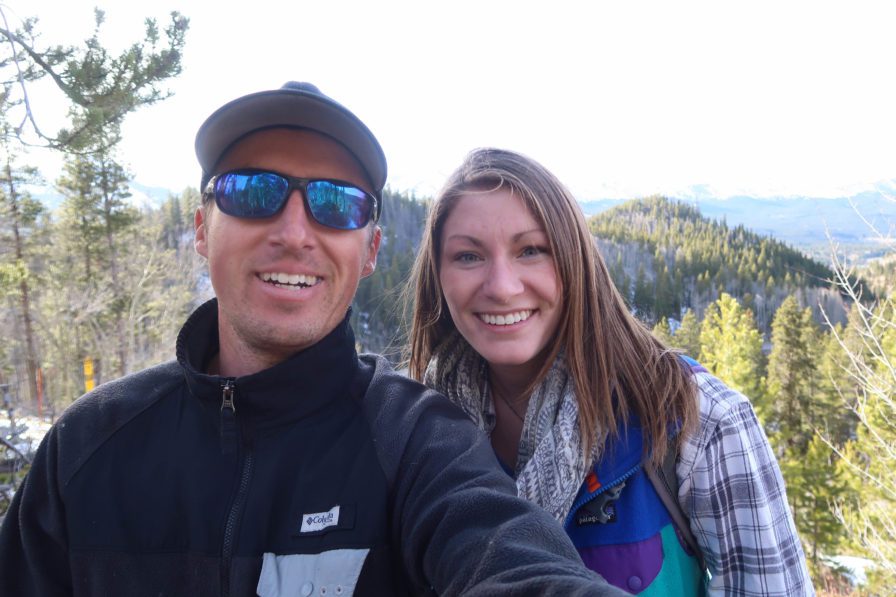
Had I not been traveling in my van, there’s no way this second meet-up with Becca would have ever taken place. I would have been forced to say, “I’m sorry, I realize we’re extremely close to one another, but it’s going to take me far too long to travel that distance on my bicycle.”
But because I had the van, I was able to turn my meet-up with Becca into a short, single-day activity. Plus, I got to see Becca again and strengthen my friendship with her just a little bit more.
None of this would have been possible if I had not been traveling in a van.
What Would You Do Differently, If You Could?
Now that I’ve been on the road for over a month now, there are several things I would like to change or do differently in the future when it comes to my #vanlife travels.
My biggest issue is storage. I simply don’t have enough places in the van to keep everything I’m carrying with me – namely my food! I’m carrying quite a bit of food at any one time and it takes up a lot of space, so in the future I think I’d like to add some cabinets or find some additional storage, somehow, to keep all my food and other accessories sorted and out of the way.
Secondly, I want to improve the solar system I already have installed in the van. Like I said before, I think the 100 watt solar panel I have on the roof of the van right now is simply not enough. I’d like to add at least one more 100 watt solar panel in the future, as well as move the solar set up from the right-hand side of the van to the left-hand side, as I think it would be easier to access on the left.
Finally, I wish there were some way to store my bicycles outside the van without having to worry about them getting stolen. Do you have any ideas on how I might be able to make this happen? I don’t see an obvious solution here, but if you have a suggestion for me, I’m more than willing to consider it.
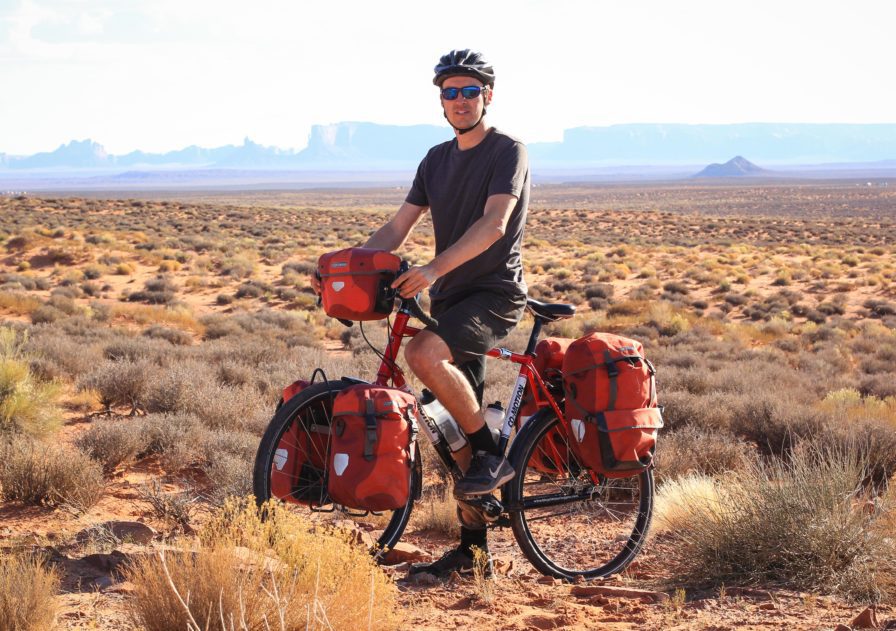
Questions & Comments About Living The Vanlife
If you have any other questions for me about my “campervan,” what it’s like to travel in a van, the bicycles I’m carrying with me on this trip, or anything else relating to my vanlife/bike tour, please leave a comment down below. I’m happy to answer any questions you might have and will continue to share the lessons I learn from my travels here on the website at www.bicycletouringpro.com.
Podcast: Play in new window | Download
Subscribe: RSS

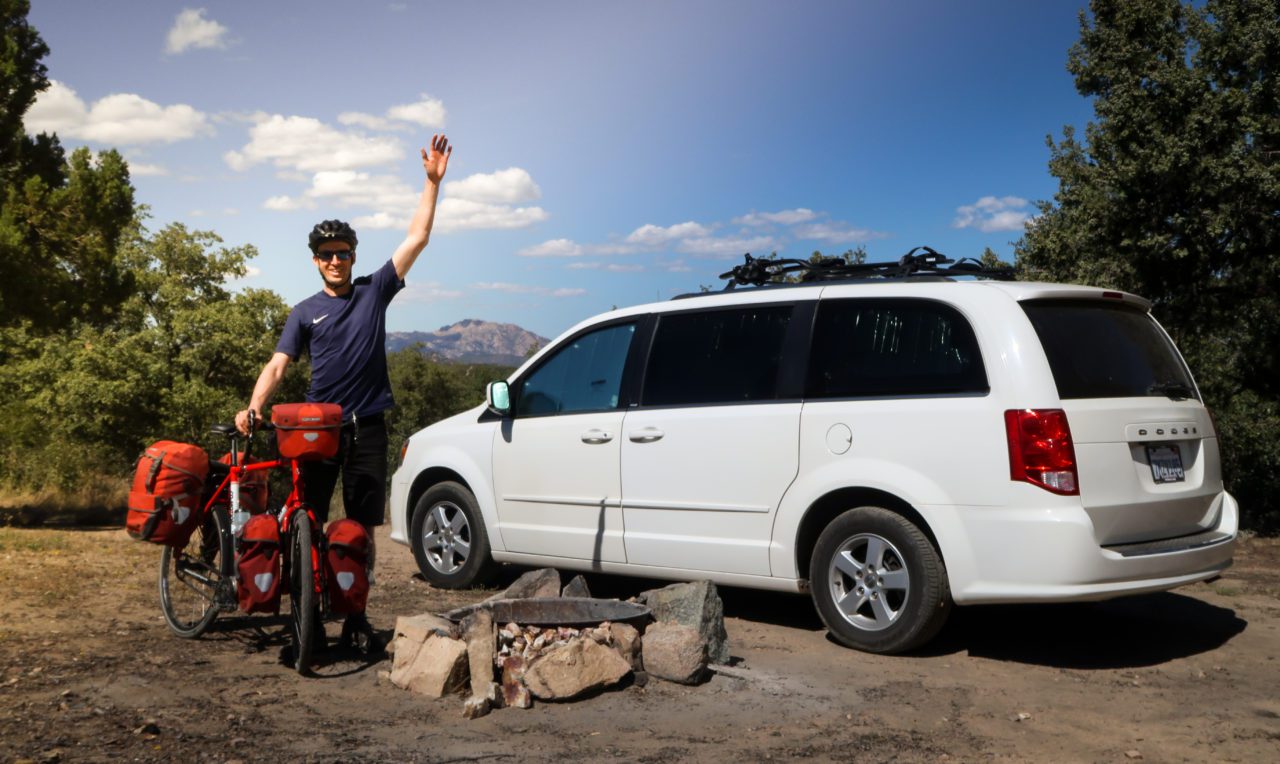
Hi Darren, I’ve got some ideas about possible possible solutions. Find some plastic milk crates that may be “laying” around. These are great for storage, easy to move and stack easy.
For your bikes could you mount an anchor point onto the vehicle chassis? Use that to lock your bikes when you’ve parked up for the night.
For the solar set up, are you referring to the panels or battery? If it’s panels go to an auto parts store and get connectors and cable to move panel to other side. The store should be able to offer advice.
Best of luck!
I’m sorry to hear that you had problems like panic attacks and not eating well. You must take care of your health. I like your new way of bike tour and encorage you to continue. You are a reference and I learn a lot of what you do. I found all the information of solar panels, batterys, way of sleeping, very useful. It’s incredible all the information you bring to us.
You smile a lot in your videos. I would like to be someone like you someday.
It was great reading about your van trip and reminded me of the yrs I spent driving a semi in the lower 48. I loved living in the truck and had my bike tied to the back of the cab. I did take short rides compared to yours because of time constraints and load responsibilities. Remember, you can always get a shower at a truck stop! It’s been a few yrs since I drove but it used to be $10. They provide soap and clean towels. You don’t have to drive a truck to get a shower although trk drivers get shower credits for their fuel purchases. The 2nd issue I am writing about is your bike storage issue. Here in AL the lawn guys often use small contained trls to hold and haul their equipment in because their equipment disappears even as they work! That is what I would do in your sitation. Maybe that could serve your needs. Be safe, stay healthy and thanks for the pleasure of reading about your travels. You also take great pics! I love the added perspectives from your drone! -Sally Nemetz
Touring the southwest US by bike and van is something I’ve been dreaming of for a long while. Thanks for sharing your experiences and personal journey. I hope you remain healthy and motivated to continue!
Some thoughts on storage while vanning. I’m a long distance cycle tourer as well as an occasional truck camper. First, your Thule will accommodate a cargo box as does mine. That double side opening streamline box holds a sizable amount of gear and is reached by standing on the rear tire (either side). On my truck I can fit the Thule Force box as well as the mounts for one bike. If I changed over to longer cross bars I could fit two bikes. You would have to work out when you were comfortable having the bikes on your racks – maybe when you are sleeping but not when shopping our absent from the vehicle. Second, I have a very good tent that is custom to fit to the rear of my truck using the bed cap lift up top half door and the tail gate. The company is DAC (https://truckminivansuvtents.com). The product works very well. There are other manufacturers that provide larger units. The add on tent does provide additional space when in camp. In addition to truck stops (think Interstates mostly) consider using an athletic club/gym/spa where many offer day rates. The ones in Flagstaff, AZ are $9.50/day but you also get to use the facilities. Also consider something that you know well: Warm Showers hosts. Last, consider changing from mini-van/suv to a used cargo van. They are much more spacious (much more depending on length/height) and readily available. Most all are based on a truck frame and drive train so they will not be as fuel efficient as your van, but the difference is not great. As you know, these working cargo vans are now very popular for DIY conversions for camping. Good luck and take care.
I’m a long distance bicycle tourer and occasional truck camper. Some thoughts: Add Thule Force or other cargo box for a nice increase in storage. Add longer cross bars to accommodate 2 bikes and a the streamlined cargo box. You’ll have to decide when bikes are on top and when in mini-van. DAC, Inc, Maurapas, LA makes very good add on tents for the rear of vans/mini-vans. For showers think of athletic clubs/YMCA’s etc. for day rate use. About $9-10/day but get to use all facilities. Also Warm Showers hosts (you are familiar with this. Consider trading mini-van for used cargo van (ford, chevy, etc.). Much roomier. Good variety in sizes (length, height). Built on truck body + drive train but gas mileage not terribly worse than mini-van.
Love to know more about your solar set up and how you modify it. Really enjoyed your video on the van life, thank you! And so sorry you had a run in with someone who was obviously having a difficult time!
Hi Darren, Not sure what mount points you have on the inside corners of your minivan, but it seems like a hammock rigged from the passenger side windshield to the right rear corner could provide flexible storage above where you store your bikes. Hammock might also be used for summer camping when its too hot inside the van.
Also, can the car alternator be used to charge the second battery when you are driving?
Darren, I saw that you want some suggestions about your van. You have plenty of room in your van. In fact, this is how you double the space your bicycles take up. Remove the front passenger seat! You can then store your bikes closer to the front of the van. When you are not using the bikes and are traveling, cover the bikes with a motorcycle cover. That keeps them out of view. Also, you can add a shower to your van. Use a 7bal bottle and attach a shower hose and small water pump. Ensure you have a long hose. Example is on bug out moto YouTube channel.
Hi Darren, have enjoyed your videos for quite some time now so a huge thanks for all the info you have posted. Regarding the solar, a big part of the problem with the panel on the roof is not the angle, but rather the shadows cast by your racks. Many people simply do not realize that even partial shading of one cell can DRAMATICALLY decrease the output of the entire panel. It’s not simply the better angle when you remove the panel from the roof, but the fact that the entire panel is now in sunshine. I doubt that installing a second panel on the roof would help much. In fact, you might be better off putting that money towards installing an isolation switch and charging from the alternator when driving. There is a fantastic site here: https://handybobsolar.wordpress.com/the-rv-battery-charging-puzzle-2/ with some reading to explain this a whole lot better than I can. A lot of it is text-heavy but SolarBob is wealth of great information.
Hi Darren,
Been wanting to give you some tips on cancer prevention in natural inexpensive self-doable ways.
Co-motion only said that their contact with you was via FaceBook, but I stay off that.
You’ll have to alter your diet.
We make Essiac Tea with ingredients from http://www.pacificbotanicals.com
The true ET recipe is here: http://www.healthfreedom.info/cancer%20essiac.htm
and yes, it’s tasty.
You’ll need a water distiller. This one on Amazon is cheap, works well:
https://www.amazon.com/Distiller-Stainless-Internal-Purifier-Effective/dp/B00N0U4S5U
There is an anti-cancer formula from Dr. John Christopher, the famous herbalist:
http://www.herballegacy.com/Blood_Stream.html
It is available here at the best rate:
https://www.amazon.com/Christophers-Original-Formulas-Clover-Combination/dp/B004JOEFAO
Lastly, study these sites:
http://www.herballegacy.com
http://www.drday.com/
Stay off sugar, alcohol, caffeine, chocolate, dairy products and ingredients, wheat flour products and ingredients, processed foods and chemical preservatives, Aspartame, Acesulfame-K, sucralose, MSG, neotame, food preservatives, salt (it has fluoride added).
Stay with organic potassium-rich foods, almost any dark green leafy vegetables.
Dr. richard Schulze: a bit pricey, but works: https://www.herbdoc.com/
God bless.
Regards,
Duncan
Hey! Awesome post! A lot of useful information. A few tips: there are different portable showers that you can get, one is a diy hand pump shower(lots of youtube videos on the easy diy shower and super cheap), and the other is a gravity shower, which you can also make a diy rig out of a water bladder/camelpak. Paint them black and now you have a solar portable shpwer that you let sit in the sun for a warm shower. You really don’t need much water to take a shower/bird bath. I can bathe in about half a gallon of water. I know you are used to not showering by now, but keeping clean is very important for your health, social interactions, and has both conscious and subconscious effects on our mental and physical wellbeing. With those two options that i provided, it is very easy to keep clean when living a nomadic lifestyle. Another suggestion is a diy portable washer which you can either buy or diy(youtube videos on making a spin cycle washer out of two buckets). This will also help keep clean and save a lot of time going to a laundromat. If you are creative, you can diy a lot of useful things that will help make your lifestyle more pleasant and enjoyable. Love from Happy Abbey!
You cannot cover any part of a solar panel or the output will drop by 95%. Its not proportional, its exponential in drop.
Yes, I know. But the bike racks are extremely important to me, so I made that sacrifice… knowing it would decrease the effectiveness of my solar panels.
Amazing blog! Thank you for all the inspiration and tips!